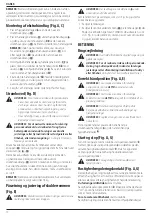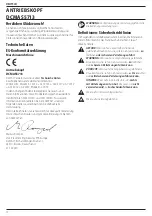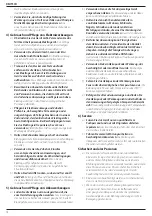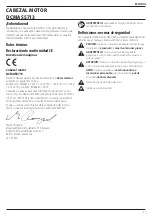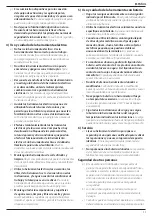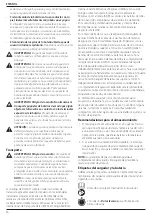
24
EngLIsh
Chargers
D
e
WALT
chargers require no adjustment and are designed to be
as easy as possible to operate.
Electrical Safety
The electric motor has been designed for one voltage only.
Always check that the battery pack voltage corresponds to the
voltage on the rating plate. Also make sure that the voltage of
your charger corresponds to that of your mains.
i
Your
D
e
WALT
charger is double insulated in
accordance with EN60335; therefore no earth wire
is required.
If the supply cord is damaged, it must be replaced only by
D
e
WALT
or an authorised service organisation.
Mains Plug Replacement
(U.K. & Ireland Only)
If a new mains plug needs to be fitted:
• Safely dispose of the old plug.
• Connect the brown lead to the live terminal in the plug.
• Connect the blue lead to the neutral terminal.
WARNING:
No connection is to be made to the
earth terminal.
Follow the fitting instructions supplied with good quality plugs.
Recommended fuse: 3 A.
Using an Extension Cable
An extension cord should not be used unless absolutely
necessary. Use an approved extension cable suitable for
the power input of your charger (see
Technical Data
). The
minimum conductor size is 1 mm
2
; the maximum length
is 30 m.
6) Service
a )
Have your power tool serviced by a qualified repair
person using only identical replacement parts.
This
will ensure that the safety of the power tool is maintained.
b )
Never service damaged battery packs.
Service
of battery packs should only be performed by the
manufacturer or authorized service providers.
Safety of Others
a ) This appliance is not intended for use by persons
(including children) with reduced physical, sensory or
mental capabilities, or lack of experience and knowledge,
unless they have been given supervision or instruction
concerning use of the appliance by a person responsible
for their safety.
b ) Children must be supervised to ensure that they do not
play with the appliance.
c ) When the appliance is stored or transported in a
vehicle it should be placed in the boot or restrained to
prevent movement following sudden changes in speed
or direction.
d ) When not in use, the appliance should be stored in a dry,
well ventilated place out of reach of children.
e ) Children should not have access to stored appliances.
preventive safety measures reduce the risk of starting the
power tool accidentally.
d )
Store idle power tools out of the reach of children
and do not allow persons unfamiliar with the power
tool or these instructions to operate the power tool.
Power tools are dangerous in the hands of untrained users.
e )
Maintain power tools and accessories. Check for
misalignment or binding of moving parts, breakage
of parts and any other condition that may affect the
power tool’s operation. If damaged, have the power
tool repaired before use.
Many accidents are caused by
poorly maintained power tools.
f )
Keep cutting tools sharp and clean.
Properly
maintained cutting tools with sharp cutting edges are less
likely to bind and are easier to control.
g )
Use the power tool, accessories and tool bits etc.
in accordance with these instructions, taking into
account the working conditions and the work to be
performed.
Use of the power tool for operations different
from those intended could result in a hazardous situation.
h )
Keep handles and grasping surfaces dry, clean and
free from oil and grease.
Slippery handles and grasping
surfaces do not allow for safe handling and control of the
tool in unexpected situations.
5) Battery Tool Use and Care
a )
Recharge only with the charger specified by the
manufacturer.
A charger that is suitable for one type
of battery pack may create a risk of fire when used with
another battery pack.
b )
Use power tools only with specifically designated
battery packs.
Use of any other battery packs may create
a risk of injury and fire.
c )
When battery pack is not in use, keep it away from
other metal objects, like paper clips, coins, keys,
nails, screws or other small metal objects, that can
make a connection from one terminal to another.
Shorting the battery terminals together may cause burns
or a fire.
d )
Under abusive conditions, liquid may be ejected
from the battery; avoid contact. If contact
accidentally occurs, flush with water. If liquid
contacts eyes, additionally seek medical help.
Liquid
ejected from the battery may cause irritation or burns.
e )
Do not use a battery pack or tool that is damaged
or modified.
Damaged or modified batteries may exhibit
unpredictable behaviour resulting in fire, explosion or risk
of injury.
f )
Do not expose a battery pack or tool to fire or
excessive temperature.
Exposure to fire or temperature
above 130 °C may cause explosion.
g )
Follow all charging instructions and do not charge
the battery pack or tool outside the temperature
range specified in the instructions.
Charging
improperly or at temperatures outside the specified range
may damage the battery and increase the risk of fire.
Содержание XR LI-ION DCMAS5713
Страница 1: ...DCMAS5713 ...
Страница 3: ...1 Fig A Fig B 16 XXXX XX XX 18 17 Fig C 13 6 15 14 1 6 14 4 15 5 7 3 2 35 19 36 34 ...
Страница 4: ...2 Fig D 5 3 1 Fig F 2 8 7 4 Fig G Fig E 8 19 20 23 6 ...
Страница 129: ......
Страница 130: ......
Страница 131: ......

